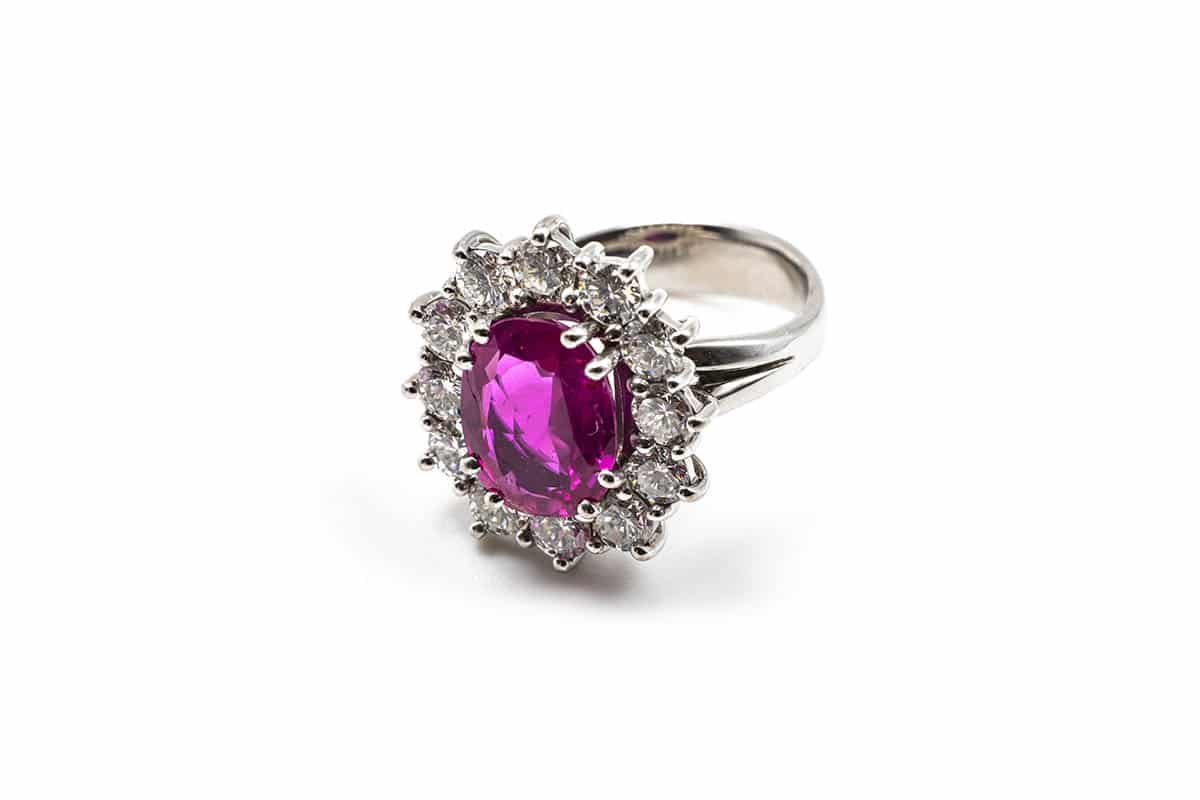Knowledge
22.02.2021 The ruby – Stone of stones
The ruby is considered the “brother” of the sapphire, as they are chemically almost identical. Both are namely varieties of the mineral corundum and have the chemical formula Al2O3.
Red corundum is always referred to as ruby, while all the other colours, from white through yellow, orange and pink to blue, are sapphires.

Corundum and therefore ruby is formed when there is an excess of aluminium and a simultaneous lack of silica in the rock. For the genesis of ruby, chromium must also be present. The trace element chromium is what gives the ruby its colour; it allows red light through, but filters out the other spectral colours, making the gemstone appear red.
Rubies occur in many different shades of red. The general rule is: the more intensive the red, the more expensive the stone. The most sought-after colour is “pigeon blood”. A gemstone with this description can be worth two to five times the price of other intense red rubies.
Ruby nearly always has inclusions, mostly these are rutile, a titanium oxide. This is actually desirable, because intact rutile needles and crystals prove that the gemstone has not been treated.
Today there are two important sources of ruby: Burma and Mozambique. There have been some small finds in the rest of Africa, as well as Afghanistan and Tajikistan.


THE RUBY AS A SYMBOL OF STRENGTH AND POWER
Up until around 1800 it was not possible to mineralogically differentiate ruby from spinel and all red gemstones were sold as expensive “rubies”.
From time immemorial, rubies have been among the most desirable gemstones. Their name comes from rubens, meaning red.
The ancient Greeks and Romans held rubies and other red stones in high esteem: the word they used for them was carbunculus and it also referred to other red stones such as garnets. For more than 1000 years rubies were, together with other hard, red gemstones, referred to as carbuncle stones.
In Sanskrit the name of the stone is Ratnaraj, which can be translated as “King of the Gemstones”; another Sanskrit name given to ruby is Ratnanayaka – “Leader of all gemstones”.
Indian mythology tells us that rubies were formed from drops of blood of the demon, Vala. In ancient India the ruby would protect its wearer from any harm while also preserving his mental and physical health. A further belief was that sacrificing a beautiful ruby to the god Krishna would ensure that one was reincarnated as a ruler.
In China, rubies and sapphires have been known and used for around 6000 years. During the Qing Dynasty, the Emperor decreed that a ruby could only be worn by a mandarin, the highest civil servant, and only on the upper side of his headwear.

THE RUBY AS A HEALING STONE IN ESOTERICISM
In esotericism the ruby is one of the stones with the strongest effect. Almost certainly because of its colour, it is assigned to the blood and the heart. The gemstone is also associated with love, passion, energy, bravery and power and, depending on the teaching, possesses the widest range of positive attributes.
Ruby is used as a healing stone in lithotherapy (crystal healing), Ayurveda and traditional Chinese medicine (TCM). Alongside a positive effect on the psyche, the ruby is attributed a healing effect on heart and circulatory diseases.
As a birthstone ruby is assigned the month of July (sometimes also June). The gemstone should bring good luck, strength and energy to anyone born in this month, as well as having other positive effects.
In astrology, however, gemstones are assigned to star signs. An amulet or talisman with a ruby can help the wearer with the star sign of Capricorn or Aries, in some cases also Scorpio and Virgo.

RUBIES IN JEWELLERY

Rubies have long been well-loved as jewellery stones. In the middle ages they were incorporated into the jewellery of rulers as a sign of power. For centuries exclusively in the realm of the aristocracy, wealthy middle-class people also began wearing rubies at the beginning of the 18th century.
Today rubies are mostly combined with gold and silver and when used in solitaire jewellery they are generally the main stone.
While for male jewellery rubies are mostly set in signet rings, in female jewellery they can be found in many more settings, such as earrings, necklaces, bracelets and rings.
In contrast to rubies for investment purposes, for use in jewellery heat-treated rubies are perfectly acceptable and cost between 30% and 90% less than naturally coloured rubies.

RUBIES AS AN INVESTMENT
For investment purposes, naturally coloured rubies of 1ct or more are suitable. Cut stones weighing more than 3ct are rare, those weighing more than 5ct extremely so and a clear, intense red ruby of more than 10ct will easily break the 3 million Euro barrier.
The most important characteristics of a ruby are its colour, its weight and its clarity. The quality of the cut is secondary in comparison with these factors.
Although previously rubies of 3ct and more were in demand, this has recently changed: today stones from 1ct upwards are now sought-after investments, meaning the demand for high quality, untreated stones is outstripping supply.
Currently nearly all rubies from the important sources in Burma and many from Mozambique are heat treated immediately after being found. Only around one in a thousand stones from Burma is good enough not to need heat treatment.
As an investment you should only buy a ruby of more than 1ct weight, better is more than 2ct. It must be a naturally coloured, untreated stone with an international certificate and should be a lively red with very slight to slight inclusions.
With a Mohs scale hardness of 9 and no true cleavage, rubies are very resilient. They are not susceptible to light, moisture or warmth. This makes them ideal for use in jewellery, but also means they can simple be kept in a safe with no fear of degradation occurring.

